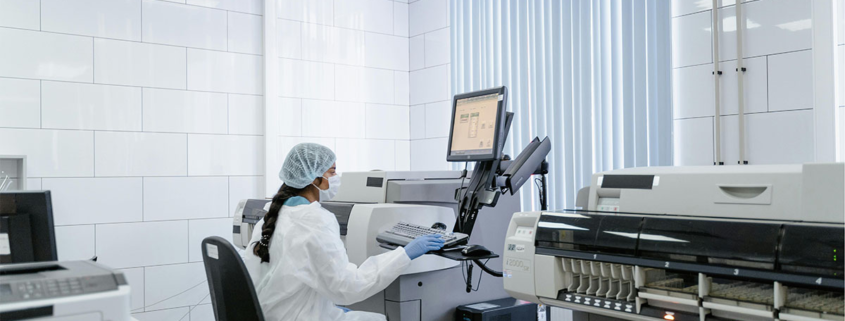Healing Hands, Powered by AI: The Revolution in Healthcare
Earlier, we explored the general impact of AI on our lives. Today, we delve into a specific sector: healthcare. As medical technology leaps forward, the AI revolution is taking center stage, promising both incredible opportunities and ethical questions.
AI Assisting the Healers
A Closer Look at Diagnostic Transformation
AI algorithms are analyzing medical scans with superhuman accuracy, aiding doctors in early disease detection and personalized treatment plans.
Superhuman Accuracy in Scan Analysis. Deep learning algorithms trained on vast datasets of medical images can outperform human radiologists in detecting certain diseases. For example, studies show AI accurately identifying early-stage lung cancer in chest X-rays with higher sensitivity than trained professionals. This translates to earlier diagnoses, potentially saving lives.
Early Disease Detection. AI’s ability to analyze subtle patterns in scans enables the detection of diseases at their earliest stages, when intervention is most effective. This is particularly crucial for cancers and neurological conditions where early diagnosis significantly improves outcomes. For instance, AI algorithms are being developed to detect Alzheimer’s disease in brain scans even before symptoms appear.
Personalized Treatment Plans. AI can analyze a patient’s unique medical history, genetic makeup, and scan results to tailor treatment plans to their specific needs. This personalized approach can lead to more effective treatments with fewer side effects. Imagine cancer treatment regimens designed based on a patient’s specific tumor mutations, maximizing efficacy while minimizing harm.
Beyond Accuracy. While impressive, AI’s role goes beyond raw accuracy. AI systems can assist radiologists by highlighting suspicious areas in scans, flagging potential errors, and suggesting additional tests. This collaboration empowers doctors to make faster and more informed decisions.
Challenges and the Future. Despite its promise, ethical considerations, data privacy concerns, and potential for bias in algorithms need careful attention. Additionally, healthcare professionals must be effectively trained to integrate AI into their workflow.
The future of AI-powered diagnostics looks bright. Continued research and development promise even more sophisticated algorithms, broader disease applications, and seamless integration into clinical practice. This ultimately benefits patients by enabling earlier diagnoses, more personalized treatments, and improved healthcare outcomes.
AI in the Operating Room: Where Robotics Meets Precision
Robotic surgery, once a futuristic vision, is now a reality, and AI is playing a crucial role in its evolution. But beyond simply guiding robotic arms, AI’s impact on surgery is multifaceted, leading to:
Minimally Invasive Procedures. Traditional surgery often involves large incisions, leading to significant pain and extended recovery times. AI-assisted robotic surgery allows for smaller, more precise incisions, minimizing tissue damage and reducing post-operative pain. This translates to quicker recoveries and shorter hospital stays, benefiting both patients and healthcare systems.
Enhanced Precision. AI algorithms can analyze pre-operative scans and intraoperative data, providing surgeons with real-time guidance and visualization during complex procedures. This precision translates to less bleeding, fewer complications, and potentially better surgical outcomes, particularly in delicate areas like the brain or spine.
Tailored Surgical Plans. By analyzing a patient’s medical history, imaging data, and genetic makeup, AI can help surgeons create personalized surgical plans. This ensures the procedure is optimized for each individual, maximizing its effectiveness while minimizing risks.
Beyond Robotics. AI’s influence extends beyond robotic arms. It can analyze surgical videos to identify potential errors in real-time, alerting surgeons to issues before they occur. Additionally, AI can predict potential complications based on patient data, allowing surgeons to take preventive measures.
Challenges and the Future. While promising, integrating AI into the operating room presents challenges. Concerns about data privacy, algorithm bias, and the potential for overreliance on technology need to be addressed. Additionally, ensuring seamless collaboration between surgeons and AI systems is crucial.
The future of AI-assisted surgery is brimming with potential. Continued development promises even more intelligent systems, wider application across surgical specialties, and improved patient safety and outcomes. Imagine a future where AI-guided robots perform complex surgeries with unmatched precision, while surgeons act as orchestrators, utilizing the technology to achieve optimal results for their patients.
AI in the Drug Discovery Lab: From Big Data to Breakthroughs
The traditional drug discovery process is notoriously slow and expensive, with a high rate of failure. However, AI is transforming this landscape by analyzing vast datasets and accelerating the journey from molecule to medicine. Here’s how:
Sifting Through Mountains of Data. Pharmaceutical research generates tremendous amounts of data, including genetic information, protein structures, and clinical trial results. AI excels at analyzing this data, uncovering hidden patterns and connections that human researchers might miss. This allows researchers to identify promising drug candidates much faster.
Predicting Drug Effectiveness. AI algorithms can analyze vast datasets to predict the effectiveness of potential drug candidates, even before they are tested in the lab. This “in silico” approach saves time and resources by guiding researchers towards molecules with higher chances of success, reducing the number of failed experiments.
Tailoring Drugs to Individuals. AI can analyze individual patient data, including genetic information and disease biomarkers, to predict which drugs are most likely to be effective for them. This personalized approach, known as precision medicine, holds immense potential for more effective and targeted treatments.
Beyond Discovery. AI isn’t just limited to identifying new drugs. It can also optimize existing drugs, design better drug delivery systems, and even predict potential side effects before they occur. This comprehensive approach helps researchers refine and improve drug candidates throughout the development process.
Challenges and the Future. While powerful, AI-driven drug discovery faces challenges. Bias in algorithms, data privacy concerns, and the need for human expertise remain crucial areas of focus. Additionally, integrating AI seamlessly into existing research workflows is paramount.
The future of AI in drug discovery is bright. Continued advancements in algorithms, access to diverse datasets, and responsible development practices promise further breakthroughs. Imagine a future where AI-powered systems rapidly identify safe and effective drugs, tailored to individual patients, dramatically accelerating the fight against disease.
But wait, there’s more on the Healthcare AI Revolution … and some concerns
Job displacement due to AI is a significant concern
While new roles will undoubtedly emerge, some existing positions may face automation, particularly those involving:
Repetitive tasks. AI excels at automating repetitive tasks, such as scheduling appointments, managing medical records, and analyzing routine lab tests. This could lead to job displacement in administrative and clerical roles.
Image analysis. AI algorithms trained on vast datasets of medical scans can outperform humans in detecting certain diseases. This could impact radiologists and other specialists who analyze images, although AI is likely to become a collaborative tool rather than a complete replacement.
Data analysis. AI can analyze complex medical data to identify patterns and trends, potentially automating tasks currently performed by data analysts or researchers.
Low-skilled roles. Jobs requiring minimal specialized skills, such as patient monitoring or basic assistance tasks, are also susceptible to automation.
However, it’s important to remember that AI is unlikely to completely replace human healthcare professionals. Here’s why:
Human touch and empathy. AI lacks the emotional intelligence and critical thinking skills necessary for tasks like patient interaction, emotional support, and complex decision-making. Nurses, doctors, and therapists will still be crucial for providing holistic care.
Expertise and judgment. While AI can analyze data, it still needs human interpretation and judgment to make critical decisions. Healthcare professionals will be needed to oversee AI systems, ensure their accuracy, and adapt them to individual patient needs.
New roles. AI will actually create new roles in healthcare, requiring skills in areas like:
- Developing and maintaining AI systems. This includes programmers, data scientists, and engineers who specialize in healthcare AI applications.
- Data privacy and security. Experts will be needed to ensure patient data privacy and security in the age of AI.
- Human-AI collaboration. Professionals who can effectively bridge the gap between humans and AI systems, ensuring their seamless interaction in healthcare settings.
Ultimately, the impact of AI on healthcare jobs will depend on several factors, including the pace of technological development, the specific tasks automated, and the willingness of healthcare systems to adapt. It’s important to prepare for potential job displacement by investing in lifelong learning and developing skills that complement, rather than compete with, AI. Continuous education and training will be crucial for healthcare professionals to thrive in this evolving landscape.
Protecting Patient Data: A Crucial Concern in AI-Driven Healthcare
Data privacy is paramount in healthcare, and the integration of AI into the field raises significant concerns. Here’s a deeper dive into the issue:
Why is data privacy crucial?
- Sensitive nature of health information: Patient data often includes highly personal and sensitive information about their medical history, diagnoses, and medications. Unauthorized access or misuse of this data could have devastating consequences, leading to discrimination, identity theft, or even blackmail.
- Increased data collection: AI models learn from data, often requiring vast amounts of patient information. This raises concerns about data collection practices, potential breaches, and secondary use of data beyond its intended purpose.
- Opaque algorithms: Many AI models, particularly complex ones, operate as “black boxes,” making it difficult to understand how they process and utilize patient data. This lack of transparency creates confusion and distrust among patients, who may be unsure how their data is being used.
What are the potential risks?
- Data breaches: Healthcare institutions are prime targets for cyberattacks, putting patient data at risk. AI systems might introduce new vulnerabilities, especially if security measures are not robust.
- Algorithmic bias: AI models trained on biased data can perpetuate discrimination against certain groups, leading to unfair diagnoses, treatment recommendations, or even insurance decisions.
- Erosion of trust: If patients lose trust in how their data is handled, they may be less willing to participate in research or use AI-powered healthcare services, hindering potential benefits.
How can we ensure ethical data use?
- Transparency and explainability: Developing AI models that are interpretable and explainable is crucial to building trust and understanding how patient data is being used.
- Strong data governance: Implementing robust data security measures, clear data collection and usage policies, and patient consent procedures is essential.
- Regulation and oversight: Establishing clear regulations and oversight mechanisms for AI development and deployment in healthcare can help mitigate risks and ensure ethical data practices.
- Patient empowerment: Giving patients control over their data, including the ability to access, correct, and withdraw consent, is key to respecting their privacy and autonomy.
Ensuring ethical data use in AI-driven healthcare requires a multi-pronged approach. Continuous collaboration between technology developers, healthcare providers, policymakers, and patients is crucial to navigate this complex landscape and ensure that AI serves as a force for good in healthcare, while protecting the fundamental right to data privacy.
Bias in AI Healthcare: A Threat to Equity and Fairness
The potential for bias in AI algorithms poses a significant challenge for healthcare, threatening to exacerbate existing inequities and lead to discriminatory outcomes. Here’s a deeper look at the issue:
Sources of Bias
- Data bias: AI models learn from data, and if the data used for training is biased, the resulting algorithm will likely inherit and amplify those biases. This can be due to historical disparities in healthcare access, documentation practices, or socioeconomic factors.
- Algorithmic bias: The design and development of AI algorithms can introduce bias through choices made by programmers, such as the features selected or the way the model is trained. Implicit biases of developers can also unknowingly influence the algorithm’s behavior.
- Interpretability issues: Many AI models operate as “black boxes,” making it difficult to understand how they arrive at their decisions. This lack of transparency can make it hard to identify and address potential biases embedded within the algorithm.
Potential Consequences
- Discriminatory diagnoses: Biased algorithms could misdiagnose certain groups of patients or suggest less effective treatments based on factors unrelated to their actual medical condition.
- Unequal access to care: AI tools used for triage or insurance decisions could disadvantage certain populations, leading to unequal access to healthcare services.
- Perpetuation of existing disparities: AI healthcare could exacerbate existing racial, socioeconomic, or gender-based disparities in health outcomes if biases are not addressed.
Mitigating Bias
- Diverse data representation: Ensuring training data reflects the diversity of the population the AI tool will serve is crucial to prevent bias. This may require actively seeking data from underrepresented groups.
- Fairness-aware algorithms: Techniques like debiasing algorithms or incorporating fairness metrics into the training process can help mitigate bias during development.
- Human oversight and interpretability: Implementing human oversight in conjunction with AI tools and developing more interpretable models can help identify and address potential biases in real-time.
- Ethical guidelines and regulatory frameworks: Establishing clear ethical guidelines and regulatory frameworks for AI development and deployment in healthcare can help ensure fair and equitable outcomes.
Addressing bias in AI healthcare is critical for ensuring fair and equitable access to quality healthcare for all. By acknowledging the problem, understanding its sources, and implementing robust mitigation strategies, we can harness the power of AI to improve healthcare for everyone, not just a privileged few. This requires a continuous commitment from researchers, developers, healthcare providers, and policymakers to build and use AI responsibly in a way that prioritizes ethical principles and promotes health equity.
Navigating the Healthcare AI Landscape
Patients
As AI plays a growing role in healthcare, patients must become informed participants in their own care. Don’t hesitate to ask your doctor or healthcare provider questions about how AI technologies are being used in your diagnosis, treatment, or other aspects of your care. Be curious about the underlying data, algorithms, and potential limitations of these tools. Openly express any concerns you might have about fairness, bias, or data privacy related to AI usage. Remember, your understanding and active engagement are crucial to navigating the evolving healthcare AI landscape and ensuring your care remains personalized, ethical, and effective.
Healthcare professionals
As healthcare professionals, we stand at the forefront of integrating AI into patient care. This necessitates embracing our dual roles: advocating for responsible AI development and continuously adapting through training. We must actively push for robust ethical guidelines, transparency in algorithms, and mitigation of potential biases to ensure AI serves patients equitably and ethically. Simultaneously, embracing ongoing training equips us to understand, utilize, and interpret AI outputs effectively, fostering optimal collaboration between humans and technology for the best possible patient outcomes. Remember, responsible AI development and continuous learning are intertwined, enabling us to navigate this evolving landscape and deliver the highest quality, AI-informed care.
Policymakers
As policymakers guiding the integration of AI in healthcare, the onus lies on us to shape a future where this technology serves ethically and equitably. We must prioritize the development of clear regulations and frameworks that address emerging concerns. This includes ensuring data privacy, mitigating algorithmic bias, fostering transparency in AI usage, and prioritizing fairness in healthcare delivery. By actively collaborating with stakeholders like healthcare professionals, patients, and technology developers, we can establish a robust policy landscape that maximizes the potential of AI while safeguarding patient rights and upholding ethical principles. Remember, responsible and collaborative policymaking is key to building trust and unlocking the true potential of AI for healthcare progress.
Stay tuned for our next issue, where we’ll explore AI’s impact on education!
Remember, the future of healthcare is collaborative. Let’s ensure humans and AI work together to achieve the best possible outcomes for everyone.
P.S. What specific questions do you have about AI in healthcare? Share them in the comments below, and we’ll address them in future issues!
Sincerely,
The AI Revolution Team









